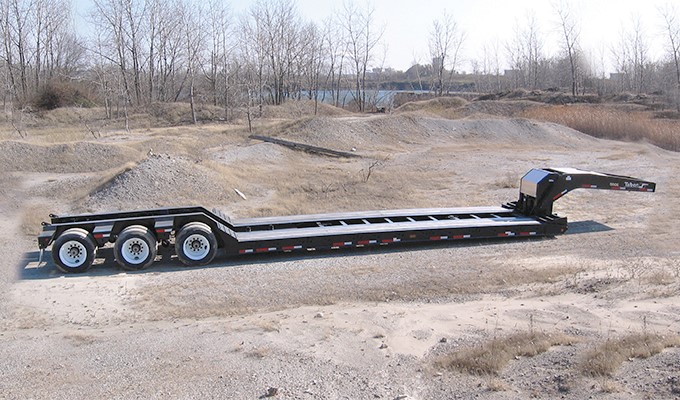Talbert Manufacturing, a North American leader in specialized heavy-haul solutions, celebrates the 75th anniversary of the release of its non-ground bearing removable gooseneck trailer. First introduced in 1947, the removable gooseneck technology revolutionized safety in the heavy haul trailer industry. Since its inception, Talbert has designed two different removable gooseneck trailers: the hydraulic detachable gooseneck trailers and the mechanical detachable gooseneck trailers.
“Safety is the hallmark of our innovative trailer designs,” says Troy Geisler, Talbert Manufacturing’s vice president of sales and marketing. “Austin Talbert designed the first gooseneck trailer to address the troubling number of injuries and deaths occurring when loading and unloading equipment. Talbert has always been on the leading edge of safe, durable trailer designs.”
Talbert first introduced the non-ground bearing hydraulic detachable gooseneck trailers in 1962. The innovative design increases safety throughout the loading and unloading process by offering ample clearance and stability. In years past, the trailer would sit upwards of 50 inches off the ground and load in the rear. The loading and unloading angle was so steep that the tipping point could be reached quickly without warning. The lower the trailer deck is, the better and safer the loading angle. That’s why Talbert Manufacturing hydraulic tail series decks can be lowered to ground height or raised to meet a shipping dock for safe loading.
Hydraulic goosenecks use hydraulic cylinders to lower and lift the deck when the trailer is attached to the truck. Talbert Manufacturing has adjusted the design of the hydraulic detachable gooseneck to meet operator requirements. In 1970, Talbert Manufacturing raised the bar with the launch of a new, patented hydraulic design called the Hydroneck.
THE HYDRONECK
The Hydroneck creates additional customization options for balancing weight distribution. Talbert customized the trailers with shims to balance weight and distribute loads without relying on preset weight or height limits. Both the double drop series and the lowboy series can feature the Hydroneck.
While the Hydroneck is a popular connection option, some operators prefer the ratchet neck design. The ratchet neck features safety pins to secure the gooseneck with five or seven preset heights which, in certain operations, can increase ease of loading and unloading. These preset heights are customizable to the application and operator need.
In 1989, Talbert designed and patented the mechanical removable gooseneck trailer. The mechanical gooseneck trailers are more lightweight than their hydraulic counterparts and don’t require hydraulics to position them. Typically double-drop trailers use this type of attachment. The mechanical gooseneck trailers use front rollers and truck ramps to connect and disconnect the trailer from the truck. These are best suited for longer-distance trucking companies where the load is on the truck for several days and unloading occurs on a smooth, flat surface.
“When it comes to our trailers, there’s so much to consider outside the type of neck or trailer weight capacity,” Geisler explains. “That’s why each trailer is built to the needs of the operator. Each trailer we build and each innovation we come up with focuses on balancing operators’ needs when it comes to productivity and safety.”
With over 75 years of experience, Talbert heavy-haul trailers continue to strive for increased safety and usability. Talbert Manufacturing matches trailer specifications with the specialized uses customers require.
Find out more, visit www.talbertmfg.com.




